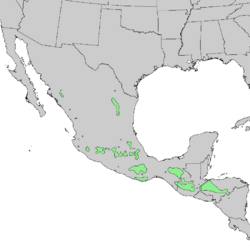Biology:Pinus pseudostrobus
| Pinus pseudostrobus | |
|---|---|

| |
| var. apulcensis in cultivation | |
| Scientific classification | |
| Kingdom: | Plantae |
| Clade: | Tracheophytes |
| Clade: | Gymnospermae |
| Division: | Pinophyta |
| Class: | Pinopsida |
| Order: | Pinales |
| Family: | Pinaceae |
| Genus: | Pinus |
| Subgenus: | P. subg. Pinus |
| Section: | P. sect. Trifoliae |
| Subsection: | P. subsect. Ponderosae |
| Species: | P. pseudostrobus
|
| Binomial name | |
| Pinus pseudostrobus | |

| |
| Natural range of Pinus pseudostrobus. Pinus pseudostrobus is also found in El Salvador.[2] | |
| Synonyms | |
|
Pinus angulata Roezl[3] Pinus astecaensis Roezl ex Gordon[4] Pinus coatepecensis (Martínez)Gaussen[3] Pinus estevezii (Martínez) J.P.Perry[3] Pinus heteromorpha Roezl[3] Pinus nubicola J.P.Perry[3] Pinus oaxana Mirov[4] Pinus orizabae Gordon[3] Pinus prasina Roezl[3] Pinus protuberans Roezl[5] Pinus regeliana Roezl[3] Pinus yecorensis Debreczy & I.Ràcz | |
Pinus pseudostrobus, known in English as the smooth-bark Mexican pine and in Spanish as chamite or pacingo, is a tree found in forests of Mexico and Central America.[1][2][6] [citation needed] It is 8 to 25 m tall with a dense and round top.[citation needed]It is threatened by logging and wood harvesting.[1] The bark is brown and fissured and smooth when young. [citation needed] It is subject to ex situ conservation.[1] It grows at altitudes between 850 and 3250 m. from 26° to 15° north latitude, from Sinaloa, Mexico to Nicaragua and Honduras. It occurs within a rainfall regime that rains mostly in summer.[citation needed]
In some forested areas like southern Nuevo León Pinus pseudostrobus is the tree with largest volume per hectare.[7]
English botanist John Lindley described the species in 1839. It is divided into Pinus pseudostrobus var.apulcensis (Lindl.)Shaw (Apulco pine), Pinus pseudostrobus f.protuberans Martínez and Pinus pseudostrobus var.pseudostrobus.[2][6]
It has been introduced in New Zealand near sea level and has done well.[citation needed]
-
Male cones at San Francisco Botanical Garden
-
Pinus pseudostrobus, Cerro Pelón, Mexico
References
| Wikimedia Commons has media related to Pinus pseudostrobus. |
- ↑ 1.0 1.1 1.2 1.3 Farjon, A. (2013). "Pinus pseudostrobus". IUCN Red List of Threatened Species 2013: e.T42404A2977667. doi:10.2305/IUCN.UK.2013-1.RLTS.T42404A2977667.en. https://www.iucnredlist.org/species/42404/2977667. Retrieved 16 November 2021.
- ↑ 2.0 2.1 2.2 "Pinus pseudostrobus". https://powo.science.kew.org/taxon/urn:lsid:ipni.org:names:314879-2.
- ↑ 3.0 3.1 3.2 3.3 3.4 3.5 3.6 3.7 "Pinus pseudostrobus var.pseudostrobus". https://powo.science.kew.org/taxon/urn:lsid:ipni.org:names:77194584-1.
- ↑ 4.0 4.1 4.2 "Pinus pseudostrobus var.apulcensis". https://powo.science.kew.org/taxon/urn:lsid:ipni.org:names:197069-2.
- ↑ "Pinus pseudostrobus f.protuberans". https://powo.science.kew.org/taxon/urn:lsid:ipni.org:names:197074-2.
- ↑ 6.0 6.1 "Pinus pseudostrobus". https://www.inaturalist.org/taxa/135769-Pinus-pseudostrobus.
- ↑ Bautista Cruz, Angelina; González Cubas, Rigoberto; Treviño Garza, Eduardo Javier; Yerena Yamallel, José Israe; Rodríguez, Eduardo Alanís; Aguirre Calderón, Oscar Alberto (2022). "Modelación de la biomasa aérea en bosques templados subtropicales secos en el noreste de México" (in Spanish). Bosque 43 (3). doi:10.4067/S0717-92002022000300243. https://www.scielo.cl/scielo.php?script=sci_arttext&pid=S0717-92002022000300243&lng=es&nrm=iso&tlng=es.
Wikidata ☰ Q137071 entry
 |




